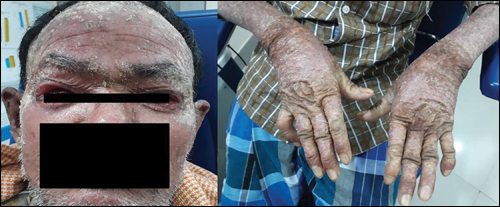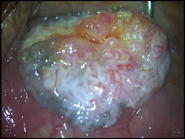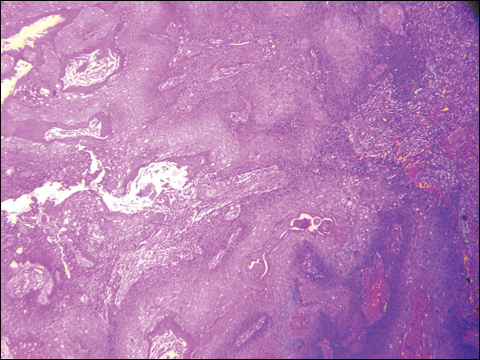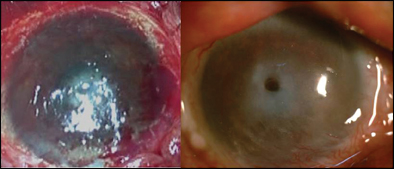Ocular surface squamous neoplasia seen in congenital ichthyosis
Ocular surface squamous neoplasia, or OSSN, is seen often as an abnormal growth in the ocular surface predominantly near the limbus. Immunosuppression and ultraviolet light exposure are known high risk factors for developing OSSN. DNA repair defects such as xeroderma pigmentosum have been reported to develop skin carcinomas. Similarly, OSSN is known to happen in xeroderma pigmentosum patients. There are few dermatological conditions in which OSSN is often noted. We report here a case of giant invasive OSSN in a patient with congenital ichthyosis.
Case study
A 44-year-old male patient came to the outpatient department in the oculoplasty specialty clinic with progressive loss of vision in his right eye for 1 year. He gave a history of a mass in the same eye for the last 4 years with progressive increase in size. The patient revealed the presence of dry scaly skin all over the body since birth, not associated with itching, pain or any discharge from skin lesions, suggestive of congenital ichthyosis, and for which he did not take any treatment as the lesions were asymptomatic. He was a farmer by occupation. He had a mixed diet and was not an alcoholic or smoker.

Source: Dhivya Ashok Kumar, MD, FRCS, FICO, FAICO, and Amar Agarwal, MS, FRCS, FRCOphth

On general examination, erythematous skin with thin white scaly lesions was seen all over the body with alopecia and madarosis, suggestive of congenital ichthyosiform erythroderma (Figure 1) and confirmed by dermatologist consultation. On ocular examination, the right eye had perception of light positive and projection of rays accurate in all quadrants. The eye had ectropion with cicatrization of the upper palpebral conjunctiva, keratinization of the bulbar conjunctiva and symblepharon superotemporally. A pink-whitish mass with patchy brown pigmentation and an irregular lobulated surface encroaching the corneal surface measuring about 10 mm by 5 mm (Figure 2) was seen in the right eye. A dilated tortuous feeder vessel from the conjunctival side was present. Anterior chamber details, the pupil, the lens and fundus details were obscured. On palpation under topical anesthesia, the mass was soft in consistency, freely movable on the conjunctival side and firmly attached to the underlying structure on the corneal side. The left eye showed symblepharon on the lateral side of the lower lid, lower punctal aplasia and pseudopterygium on the temporal side; the rest of the anterior segment was normal, as was the dilated fundus examination. In the left eye, uncorrected distance visual acuity was 20/20, with near visual acuity of N10.


Clinical examination led to the provisional diagnosis of OSSN in the right eye. Ultrasound biomicroscopy showed no invasion into the anterior chamber. MRI of the orbit showed an irregular lobulated lesion on the anterior ocular surface with no extension into the orbit or surrounding soft tissue. Symblepharon release, excision biopsy of the mass lesion and double freeze-thaw cryotherapy of the conjunctiva, with reconstruction of the ocular surface with amniotic membrane transplantation, were planned. After obtaining written informed consent, under strict aseptic conditions and peribulbar anesthesia, the mass was excised with margins including the 3-mm clear area surrounding the mass. After confirmation from histopathological report that the margins were free of tumor cells, de novo excised margins of the conjunctiva were thawed with the double freeze-thaw technique with a cryotherapy probe. The corneal side lesion was managed with partial keratectomy. The conjunctival defect and corneal surface were covered with amniotic membrane graft and secured with 6-0 Vicryl sutures. Histopathology of the main mass confirmed an invasive well-differentiated squamous neoplasia with keratin pearls and pigment laden macrophages (Figure 3).
Postoperatively, topical moxifloxacin 0.5% eye drops four times a day and topical prednisolone acetate 1% eye drops four times a day for 4 weeks and topical mitomycin C 0.04% eye drops with 1 week on and 1 week off for three cycles in the right eye were prescribed. Topical tear substitute eye drops every 2 hours in both eyes were prescribed. The patient was followed up from day 1 to 7, weekly for 1 month and monthly for 6 months. The necessity for lifelong follow-up was explained to the patient. Impression cytology of the pterygium in the other eye was carried out to rule out any subclinical OSSN. No recurrence was noted over the 6 months; however, thinning of corneal stroma (Figure 4) was noted, for which tissue glue was applied with a recommendation for a localized patch graft. Visual acuity was counting fingers 1 meter at 1 month follow-up and remained so due to the dense corneal scar. There was a persistent scar at 3 months’ follow-up.
Ocular complications of congenital ichthyosiform erythroderma
Congenital ichthyosiform erythroderma is one of the five distinct forms of ichthyosis. Usual ocular associations in ichthyosis are ectropion, blepharitis, meibomian gland absence, trichiasis, madarosis, absence of lacrimal puncta, keratinization and thickening of conjunctiva, and limbal stem cell deficiency. Enlarged corneal nerves are a uniform finding in all forms of ichthyosis. The cornea may show recurrent corneal erosions, band keratopathy, Salzmann nodules, stroma vascularization or unilateral megalocornea and rarely microphthalmos or anterior chamber cleavage syndrome. The retina may show coloboma, retinitis pigmentosa, maculopathy and tortuous vessels. Increased risk for various malignancies in ichthyosis were reported, such as squamous cell carcinoma (SCC) of the larynx, nasal ala, vulva, penis, oral mucosa or uterus, or multiple aggressive cutaneous malignancies.
Depending on features such as scarring alopecia, ectropion, punctal aplasia, keratinization of conjunctiva and generalized red skin with thin white scales all over the body, congenital ichthyosiform erythroderma was confirmed. Ectropion causing exposure keratopathy or severe limbal stem cell deficiency could be the cause of the symblepharon in our case. Because the patient was a farmer, he might have been exposed to UV light in the open fields for many years. As the left eye had pterygium, the lesion in the right eye also might have started as pterygium initially, and OSSN might have developed from pre-existing pterygium, later transforming into invasive SCC.
Because the patient was treated in the late stage of the disease, even though the surgical excision was successful, the visual prognosis was poor due to the dense central scar. Further studies are required to explore the associations between dermatological conditions such as ichthyosis and OSSN. Nevertheless, we can conclude that this report helps to prompt ophthalmologists to advise screening and regular lifetime follow-up for patients with congenital ichthyosis for ocular surface neoplasia.
- References:
- Al-Amry MA. Saudi J Ophthalmol. 2016;doi:10.1016/j.sjopt.2015.12.004.
- Brooks BP, et al. Ophthalmology. 2013;doi:10.1016/j.ophtha.2012.12.044.
- Brown VL, et al. Br J Dermatol. 2008;doi:10.1111/j.1365-2133.2008.08463.x.
- Chui J, et al. Am J Pathol. 2011;doi:10.1016/j.ajpath.2010.10.037.
- Fadare O. Diagn Pathol. 2006;doi:10.1186/1746-1596-1-8.
- Hirst LW, et al. Arch Ophthalmol. 2009;doi:10.1001/archophthalmol.2008.531.
- Isharwal S, et al. Urology. 2015;doi:10.1016/j.urology.2014.12.042.
- Kübler HC, et al. Gebutshilfe Frauenheilkd. 1987;47(10):742-744.
- Lee GA, et al. Surv Ophthalmol. 1995;doi:10.1016/S0039-6257(05)80054-2.
- Macarez R, et al. Cornea. 1999;18(4)495-497.
- McKelvie PA, et al. Br J Ophthalmol. 2002;doi:10.1136/bjo.86.2.168.
- Schiraldi FG, et al. J Am Podiatr Med Assoc. 1987;doi:10.7547/87507315-77-11-607.
- Suarez MJ, et al. Ocul Oncol Pathol. 2015;doi:10.1159/000441527.
- Wirsching KE, et al. BMC Ear Nose Throat Disord. 2013;doi:10.1186/1472-6815-13-7.
- Zoroquiain P, et al. Saudi J Ophthalmol. 2016;doi:10.1016/j.sjopt.2016.02.007.
- For more information:
- Amar Agarwal, MS, FRCS, FRCOphth, is director of Dr. Agarwal’s Eye Hospital and Eye Research Centre. Agarwal is the author of several books published by SLACK Incorporated, publisher of Ocular Surgery News, including Phaco Nightmares: Conquering Cataract Catastrophes, Bimanual Phaco: Mastering the Phakonit/MICS Technique, Dry Eye: A Practical Guide to Ocular Surface Disorders and Stem Cell Surgery and Presbyopia: A Surgical Textbook. He can be reached at 19 Cathedral Road, Chennai 600 086, India; email: dragarwal@vsnl.com; website: www.dragarwal.com.
Disclosure: Agarwal reports he is a paid consultant for Staar Surgical. Kumar reports no relevant financial disclosures.
